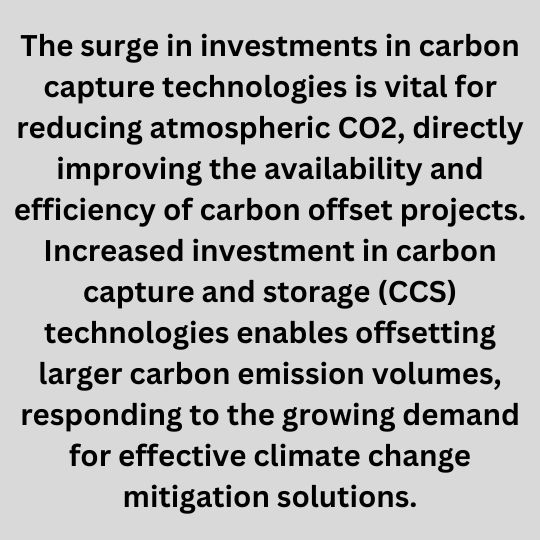NEW YORK, January 16, 2024 – The carbon offset market was valued at USD 53.3 billion in 2023 with a significant growth and is projected to reach at USD 754.9 billion by 2033 with an outstanding CAGR of 31.24%.
According to Marketresearch.biz, carbon offsets, measured in metric tons of CO2e, provides a vital possibility for reducing climate change. Allied with regulatory frameworks, particularly the EU’s determination emission decrease targets, they offer businesses and individuals a means to invest in environmental projects to reimburse for their emissions. The rise in global regulatory initiatives, along with corporations implementing net-zero targets, has compelled a substantial demand for credible carbon offsets.
In 2023, top businesses used 37.8 million carbon offsets, demonstrating 5% of the voluntary market credits over three years. As companies strive to meet climate goals, the market for effective offsets grows, presenting an opportunity for market expansion. New carbon-trading networks, personalized to localized actions, provide association and investment chances, answering to the demand for personalized offset solutions. Paraguay’s recent law creating a carbon credit registry further improves transparency and organization in the market.

Incorporating carbon offsets into consumer choices taps into the increasing conscious consumerism trend. Businesses implanting offset options into consumer-facing platforms can attract environmentally aware customers, fostering growth and highlighting obligation to sustainability. Innovations like Building-Integrated Photovoltaics contribute to offset goals by producing renewable energy and decreasing reliance on emissions-intensive power sources.
The compliance market rules the type market segment due to regulatory mandates requiring companies to offset their carbon emissions.
Avoidance or reduction project dominates the project type market segment as it prevents the carbon emissions or reducing existing emissions.
The energy sector leads the end-use market segment due to carbon offset projects that comprises of transitioning to renewable energy and implementing carbon capture and storage solutions.
North America leads the global carbon offset market with a 31% share, compelled by strong climate change initiatives and corporate responsibility.
Driving Factors
Corporate Carbon Goals Compels the Market Growth
More companies commit to reducing their carbon footprint, the demand for carbon offsets as a tool to achieve these goals increases. Businesses are utilizing carbon offsets to compensate for emissions they cannot eliminate through direct actions. According to the United Nations, more than 9,000 companies, over 1,000 cities, more than 1,000 educational institutions, and over 600 investors have committed to achieving a solution to net-zero emissions by 2050. The commitment to carbon neutrality and net zero targets by a growing number of corporations suggests a continued expansion of the carbon offset market, underpinned by corporate efforts to address climate change.
Regulatory & Government Policies
These regulations often include mechanisms like cap-and-trade systems or carbon taxes that incentivize or mandate the use of carbon offsets. Governments worldwide are implementing policies that require or encourage carbon offsetting as part of broader climate change and sustainability initiatives. This regulatory environment not only promotes the growth of the carbon offset market but also ensures its integration into national and international climate strategies. These regulations often include mechanisms like cap-and-trade systems or carbon taxes that incentivize or mandate the use of carbon offsets.
Absence of Preparation for New Market Mechanisms Limits
Many regions and organizations are unprepared for this transition, lacking the necessary infrastructure, legal frameworks, or technical expertise. This unpreparedness can delay the establishment and efficient functioning of carbon markets, limiting the ability to scale up and attract broader participation. By leveraging advanced algorithms and predictive models, generative AI can play a crucial role in streamlining and optimizing the intricate processes involved in carbon trading.
Growth Opportunities
Increase in Carbon Capture Investments
Carbon capture technologies play a critical role in reducing atmospheric CO2, and their advancement directly increases the availability and efficacy of carbon offset projects. Businesses and governments invest more in carbon capture and storage (CCS) technologies, the capacity to offset larger volumes of carbon emissions expands. This investment is a response to the growing demand for effective solutions to mitigate the impact of climate change. The ongoing investment in these technologies suggests a future where carbon offsets become an integral part of global climate strategies, indicating sustained growth in the market driven by technological advancements in carbon capture.
Regional Analysis
North America leads the global carbon offset market with a 31% share, compelled by strong climate change initiatives and corporate responsibility. Policy support and consumer demand for sustainability underwrite to the market’s growth. Europe, a forerunner in climate action, sees expansion through the EU Emissions Trading System. In Asia-Pacific, the market is emerging with rising environmental consciousness, renewable energy investments, and considerable potential for growth.
Segment Analysis
By type, the compliance market rules the market segment due to regulatory mandates requiring companies to offset their carbon emissions. This segment’s dominance is underpinned by government-imposed carbon reduction targets and cap-and-trade schemes, where entities must purchase carbon credits to comply with emission caps. It is important in industries like energy, manufacturing, and transportation, where emissions are customarily high. This market is characterized by a more formal and regulated structure, offering standardized and verified carbon credits.
By project, avoidance or reduction project dominates the market segment as it prevents the carbon emissions or reducing existing emissions. The popularity of these projects lies in their immediate impact on reducing emissions and their alignment with sustainable development goals. These projects include renewable energy initiatives, energy efficiency improvements, and methane capture. Removal or sequestration projects involve the capture and storage of carbon dioxide from the atmosphere.
By end-use, the energy sector leads the market segment due to carbon offset projects that comprises of transitioning to renewable energy, refining energy efficiency, and implementing carbon capture and storage solutions. The transportation sector is focusing on offsets through cleaner fuel initiatives and efficiency improvements. The aviation industry is increasingly investing in carbon offsets to mitigate its environmental impact.